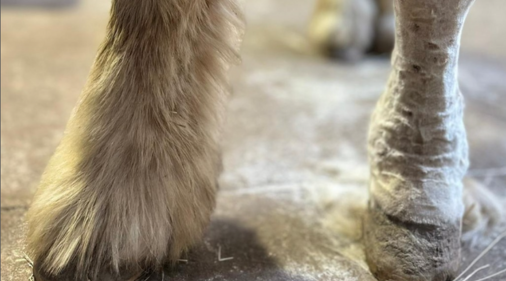News | 14 June 2023
Managing Chronic Progressive Lymphedema in Horses: The Importance of Clipping Feathers
Chronic Progressive Lymphedema (CPL), also known as "Capped Hocks and Swelling Legs Syndrome," is a condition that affects horses, particularly heavy draft breeds and crosses. It involves the accumulation of fluid and swelling in the lower limbs, leading to discomfort, reduced mobility, and potential secondary infections. While there is no cure for CPL, proactive management strategies, such as clipping, can significantly improve the horse's quality of life.
But why does clipping the feathers of a horse with CPL help manage the disease?
- Managing Moisture and Hygiene
Feathers are a characteristic feature of certain breeds, including draft horses and their crosses. While feathers add to the breed's aesthetic appeal, they can also pose a challenge when managing Chronic Progressive Lymphedema. The feathers tend to trap moisture, dirt, and bacteria, creating an ideal environment for the growth of harmful microorganisms. This increased moisture and potential for infection can exacerbate the symptoms of CPL.
Clipping the feathers helps to reduce the moisture build-up and improves hygiene in the affected areas. It allows for better air circulation, keeping the skin drier and minimizing the risk of bacterial or fungal infections. By maintaining a clean and dry environment, the horse's legs are better equipped to heal and prevent the progression of the condition.
- Easier Wound Care and Monitoring
CPL often leads to the development of wounds, sores, or skin ulcers on the affected legs. These open wounds can be challenging to manage and heal due to the presence of feathers. Feathers can interfere with the application of topical treatments, impede proper cleaning, and hinder effective wound monitoring.
Clipping the feathers provides unobstructed access to the affected areas, making wound care more manageable. It allows for thorough cleaning, application of medications or dressings, and regular monitoring of the wound's progress. By keeping the affected areas free of hair, you can provide more effective and timely treatment, helping to prevent complications and promote faster healing.
- Easing Exercise and Mobility
Horses with Chronic Progressive Lymphedema may experience discomfort, swelling, and reduced mobility in their lower limbs. The feathers around the legs can exacerbate these issues by adding weight, trapping heat, and limiting movement. They can also become tangled or matted, leading to discomfort and further hindrance of the horse's mobility.
Clipping the feathers helps alleviate these challenges by reducing the weight and heat retention in the affected areas. It allows for better freedom of movement, which can contribute to improved circulation and lymphatic drainage. With increased mobility, the horse can exercise more comfortably, which is crucial for managing CPL and preventing secondary complications such as muscle atrophy or joint stiffness.
Clipping the feathers is an essential management practice for horses with Chronic Progressive Lymphedema. It helps maintain moisture control, promotes hygiene, facilitates proper wound care, and improves the horse's overall mobility and comfort. While feather clipping may alter the breed's traditional appearance, the benefits it offers in managing CPL outweigh the aesthetic considerations. It is crucial to consult with a veterinarian or an experienced equine professional to determine the appropriate feather clipping schedule and techniques for each affected horse. By incorporating feather clipping into the management plan, you can provide your horse with a better quality of life and mitigate the challenges associated with Chronic Progressive Lymphedema.

